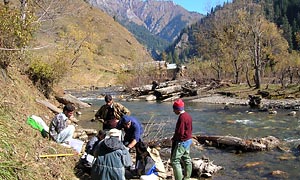Efficacy of conservation actions for native fishes in tributaries of the Colorado River, Grand Canyon
Date:
2018-2021
Abstract:
The predominantly endemic fishes of the American Southwest are highly imperiled due to pervasive hydrological alteration of aquatic habitats through river regulation and human water use, compounded by the widespread introduction of nonnative competitors and predators. The Colorado River’s desert fishes evolved in an environment characterized by seasonally variable temperatures and frequent flooding and drought. However, stabilized flow and thermal regimes in the post-dam era favor nonnative fishes whose life history strategies evolved in stable and predictable environments. In the Grand Canyon, Arizona, conservation actions including nonnative fish suppression and flow experiments designed to benefit nearshore habitats and encourage juvenile fish recruitment, have been underway to recover the endangered humpback chub (Gila cypha). Yet the responses in the population dynamics of both native and nonnative fishes to these conservation actions have been equivocal; environmental variability and ecosystem complexity have sometimes confounded the interpretation of results. Two recent experimental conservation actions have been implemented in tributaries within Grand Canyon National Park including the intensive stream-wide suppression of nonnative brown trout (Salmo trutta) and rainbow trout (Oncorhynchus mykiss) in Bright Angel Creek, and translocations of humpback chub. The aim of these actions is to enhance resiliency and redundancy of the Grand Canyon humpback chub population, reduce the risk of predation by nonnative salmonids, and enhance native fish populations. Translocations are conducted in three tributaries of differing physical and biological attributes, following nonnative fish suppression. The objectives of this study are to assess the efficacy of these efforts in restoring native fish communities and establishing reproducing populations of humpback chub, by 1) quantifying the effects of nonnative suppression and environmental variability on demographic vital rates (i.e., survival, recruitment, mortality) of native fishes and introduced salmonids; 2) assessing factors contributing to the likelihood of establishing self-sustaining humpback chub populations in small Colorado River tributaries; and, 3) developing an integrated population model for brown trout to quantify future levels of suppression necessary to reduce or eradicate the population in the Grand Canyon and beyond. Through detailed evaluations of humpback chub vital rates in translocated populations, plans for the reestablishment of the species in the Upper Colorado River Basin may be more-informed. Detailed examination of the response of brown trout, one of the most destructive invaders introduced across the globe, will assist fisheries managers in designing mechanical control strategies where eradication through chemical means is not a socially or logistically acceptable option.
Funding:
- US Department of Interior – Bureau of Reclamation
- US Department of Interior – National Park Service, Grand Canyon National Park
- Utah State University – Center for Colorado River Studies, Department of Watershed Sciences
- Grand Canyon Association
- United States Geological Survey – Utah Cooperative Fish and Wildlife Research Unit (In-kind)
- Albright-Wirth Grant Program, administered by the National Park Foundation and the NPS Learning and Development Program
Investigators:
- Dr. Phaedra Budy, Principle Investigator, USU – Dept. of Watershed Sciences
- Brian Healy, PhD student, USU – Dept. of Watershed Sciences, and the Ecology Center
- Dr. Mark McKinstry, Project Scientist, Bureau of Reclamation




